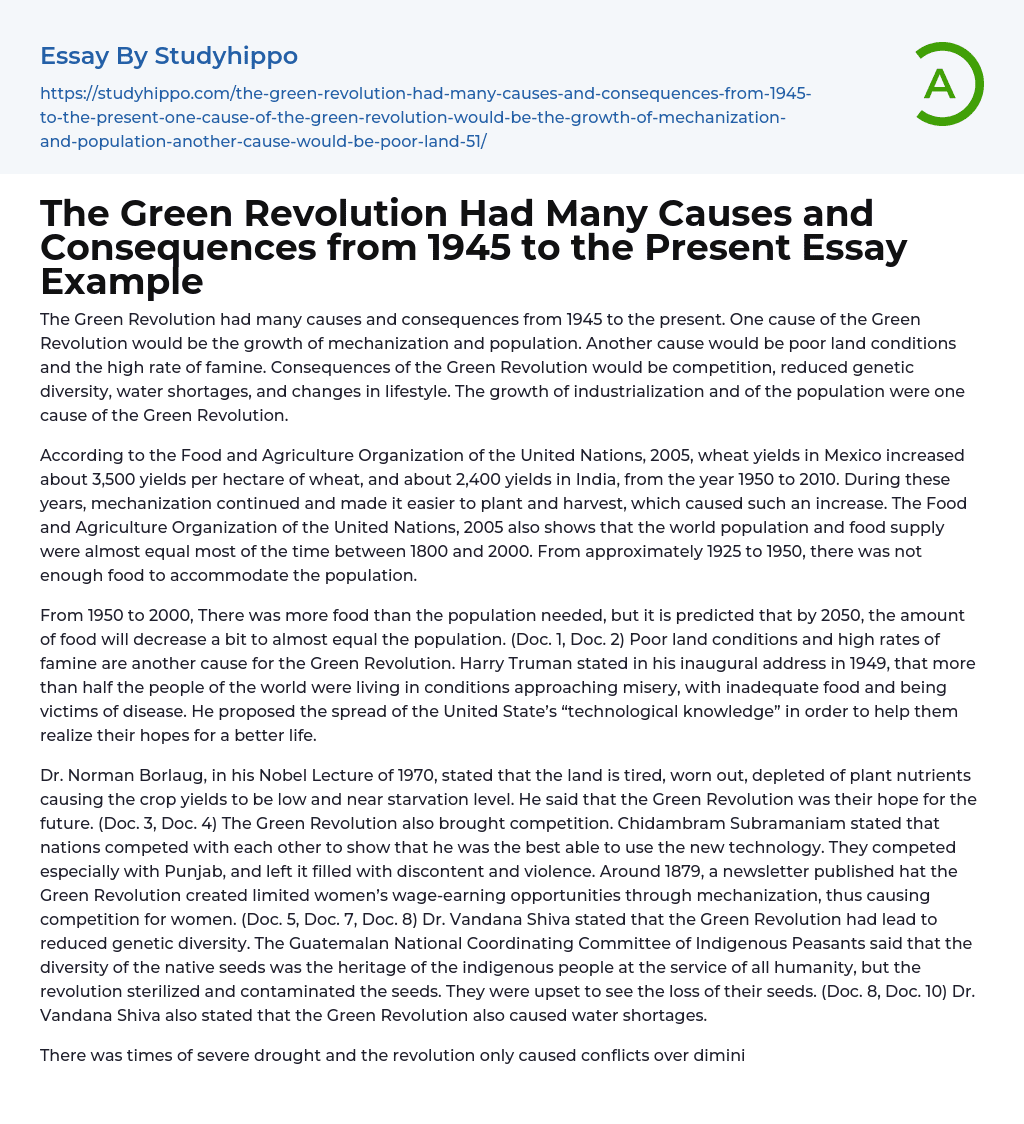

The Green Revolution Had Many Causes and Consequences from 1945 to the Present Essay Example
The Green Revolution had many causes and consequences from 1945 to the present. One cause of the Green Revolution would be the growth of mechanization and population. Another cause would be poor land conditions and the high rate of famine. Consequences of the Green Revolution would be competition, reduced genetic diversity, water shortages, and changes in lifestyle. The growth of industrialization and of the population were one cause of the Green Revolution.
According to the Food and Agriculture Organization of the United Nations, 2005, wheat yields in Mexico increased about 3,500 yields per hectare of wheat, and about 2,400 yields in India, from the year 1950 to 2010. During these years, mechanization continued and made it easier to plant and harvest, which caused such an increase. The Food and Agriculture Organization of the United Na
...tions, 2005 also shows that the world population and food supply were almost equal most of the time between 1800 and 2000. From approximately 1925 to 1950, there was not enough food to accommodate the population.
From 1950 to 2000, There was more food than the population needed, but it is predicted that by 2050, the amount of food will decrease a bit to almost equal the population. (Doc. 1, Doc. 2) Poor land conditions and high rates of famine are another cause for the Green Revolution. Harry Truman stated in his inaugural address in 1949, that more than half the people of the world were living in conditions approaching misery, with inadequate food and being victims of disease. He proposed the spread of the United State’s “technological knowledge” in order to help them realize their hopes for a better life.
Dr. Norman Borlaug
in his Nobel Lecture of 1970, stated that the land is tired, worn out, depleted of plant nutrients causing the crop yields to be low and near starvation level. He said that the Green Revolution was their hope for the future. (Doc. 3, Doc. 4) The Green Revolution also brought competition. Chidambram Subramaniam stated that nations competed with each other to show that he was the best able to use the new technology. They competed especially with Punjab, and left it filled with discontent and violence. Around 1879, a newsletter published hat the Green Revolution created limited women’s wage-earning opportunities through mechanization, thus causing competition for women. (Doc. 5, Doc. 7, Doc. 8) Dr. Vandana Shiva stated that the Green Revolution had lead to reduced genetic diversity. The Guatemalan National Coordinating Committee of Indigenous Peasants said that the diversity of the native seeds was the heritage of the indigenous people at the service of all humanity, but the revolution sterilized and contaminated the seeds. They were upset to see the loss of their seeds. (Doc. 8, Doc. 10) Dr. Vandana Shiva also stated that the Green Revolution also caused water shortages.
There was times of severe drought and the revolution only caused conflicts over diminishing water sources. Intensive irrigation led to large-scale storage systems, centralizing control over water supplies and leading to local and interstate water conflicts. (Doc. 10) One of the social consequences of the Green Revolution was changes in lifestyle. The Human Development Report, issued by the government of the State of Punjab, India in 2004, states that one important social consequence of the Green Revolution was the disappearance of caste rigidities and the
emergence of the middle and rich peasants as the dominant peasantry in the state.
The traditional “extended family” was gradually replaced with the “nuclear family”. Mrs. Dula, the wife of a Mexican agricultural official stated in 1970 that there were never before seen houses with swimming pools in Mexico City. The people had so much money and the wives of these rich Mexican farmers would save up once a month to go shopping. (Doc. 9, Doc. 6) One additional document that would’ve been helpful in this analysis of the Green Revolution would’ve been a scientific and social representative of Europe to show the effects the Green Revolution had.
There were multiple representatives of India and the United States, but there weren’t any representatives of any part of Europe to say that the land was in bad condition or that there was any kind of famine. The Green Revolution had it’s share of benefits for different parts of the world, but it also had it’s negatives, such as diminishing water resources. The revolution was successful in providing more food, but it in turn damaged some more land. The Green Revolution also changed the way of living of the entire world. Nuclear families replaced the, once common, extended families.
- Agriculture essays
- Albert einstein essays
- Animals essays
- Archaeology essays
- Bear essays
- Biology essays
- Birds essays
- Butterfly essays
- Cat essays
- Charles Darwin essays
- Chemistry essays
- Dinosaur essays
- Discovery essays
- Dolphin essays
- Elephant essays
- Eli Whitney essays
- Environmental Science essays
- Evolution essays
- Fish essays
- Genetics essays
- Horse essays
- Human Evolution essays
- Isaac Newton essays
- Journal essays
- Linguistics essays
- Lion essays
- Logic essays
- Mars essays
- Methodology essays
- Mineralogy essays
- Monkey essays
- Moon essays
- Mythology essays
- Noam Chomsky essays
- Physics essays
- Plate Tectonics essays
- Progress essays
- Reaction Rate essays
- Roman Numerals essays
- Scientific essays
- Scientific Method essays
- Scientist essays
- Seismology essays
- Space Exploration essays
- Stars essays
- Sun essays
- Thomas Edison essays
- Tiger essays
- Time Travel essays
- Universe essays



